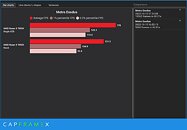- Joined
- Oct 9, 2007
- Messages
- 47,880 (7.38/day)
- Location
- Dublin, Ireland
| System Name | RBMK-1000 |
|---|---|
| Processor | AMD Ryzen 7 5700G |
| Motherboard | Gigabyte B550 AORUS Elite V2 |
| Cooling | DeepCool Gammax L240 V2 |
| Memory | 2x 16GB DDR4-3200 |
| Video Card(s) | Galax RTX 4070 Ti EX |
| Storage | Samsung 990 1TB |
| Display(s) | BenQ 1440p 60 Hz 27-inch |
| Case | Corsair Carbide 100R |
| Audio Device(s) | ASUS SupremeFX S1220A |
| Power Supply | Cooler Master MWE Gold 650W |
| Mouse | ASUS ROG Strix Impact |
| Keyboard | Gamdias Hermes E2 |
| Software | Windows 11 Pro |
AMD Ryzen 9 7950X 16-core processor exhibits some strange behavior with regards to the max boost frequency spread among its cores. A multi-chip module with two 8-core CCDs (CPU complex dies); we noticed early on in our review that the cores located in CCD-1 boost to a higher frequency than the ones in CCD-2, with differences as high as 300 MHz. CapFrameX noticed that when CCD-2 is disabled on a machine running Windows 11 22H2, the processor actually puts out higher gaming performance, by as much as 10%. This is mainly because the cores in CCD-2, with a lower maximum boost frequency no longer handle processing load from the game; and with CCD-2 disabled, CCD-1 has all of the processor's power budget—up to 230 W—to itself, giving it much higher boost residency across its 8 cores.

View at TechPowerUp Main Site | Source

View at TechPowerUp Main Site | Source





